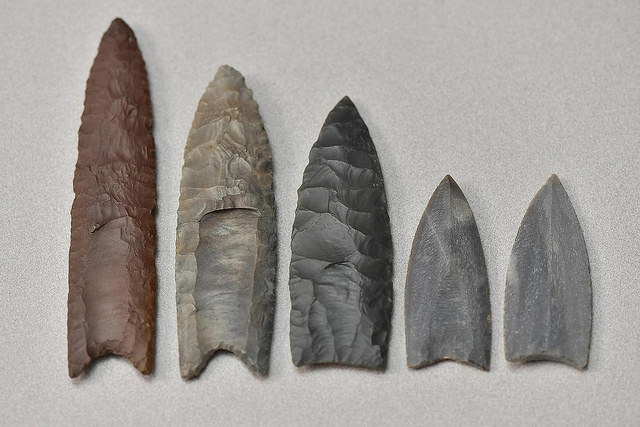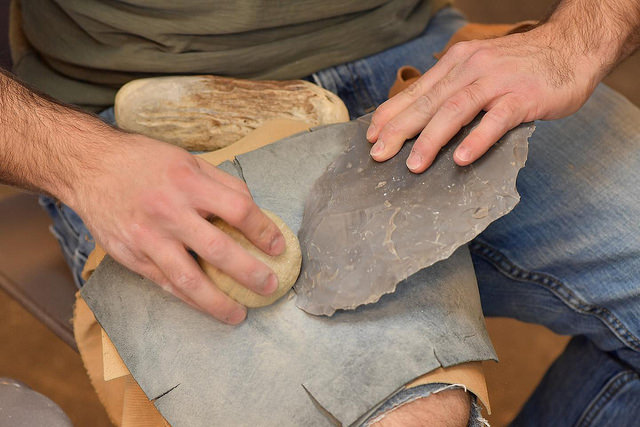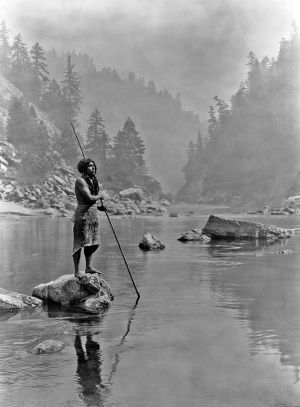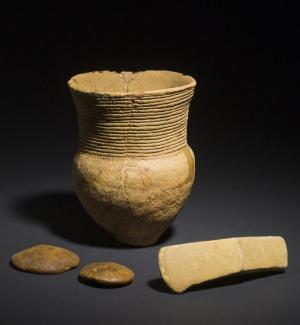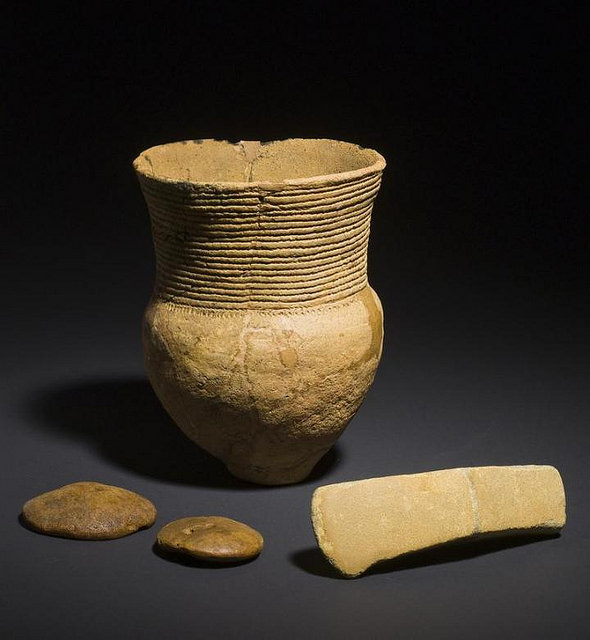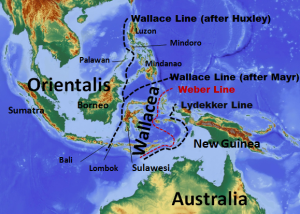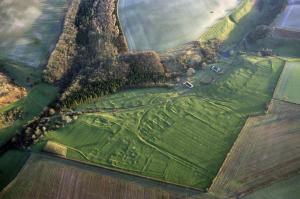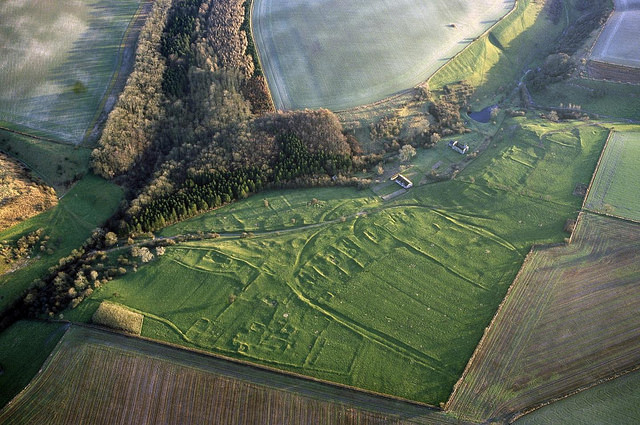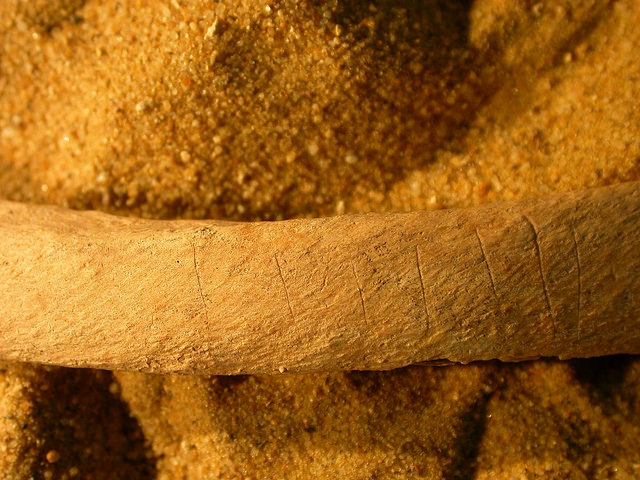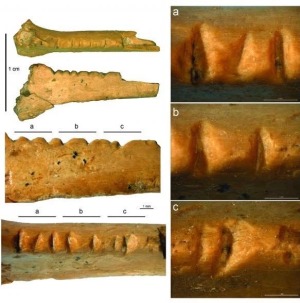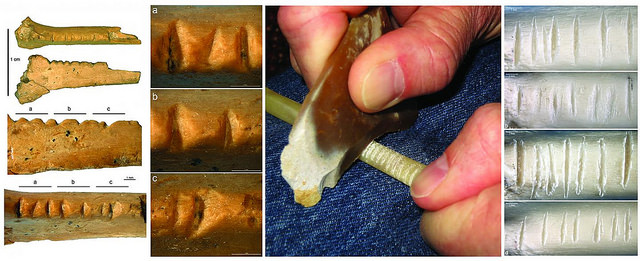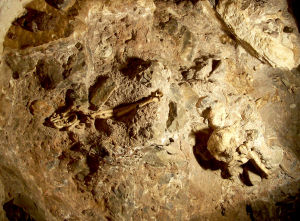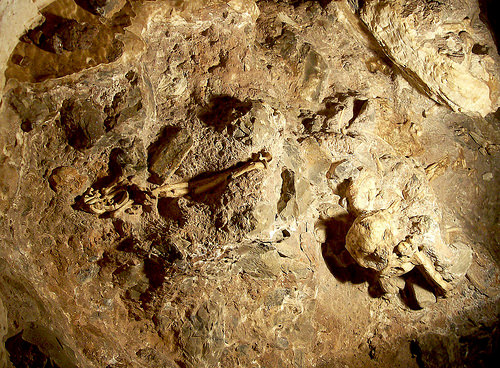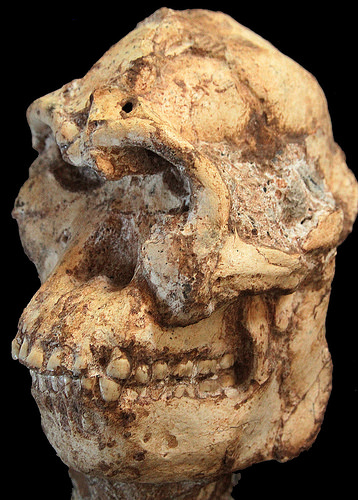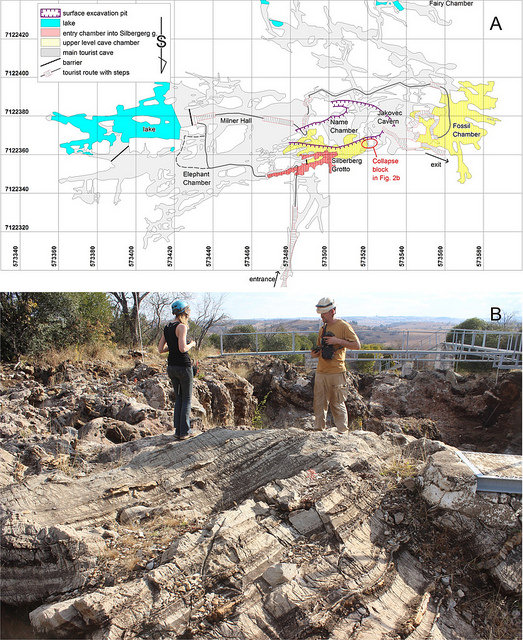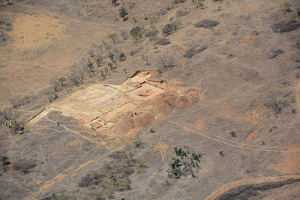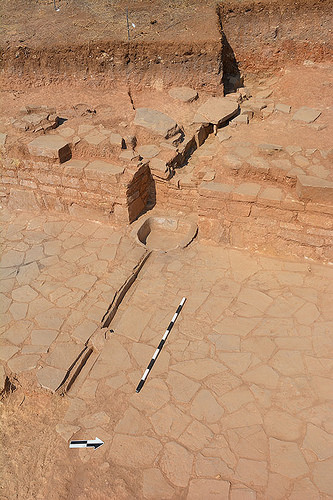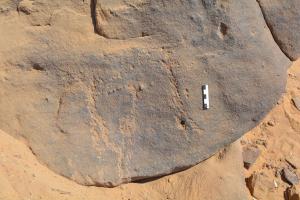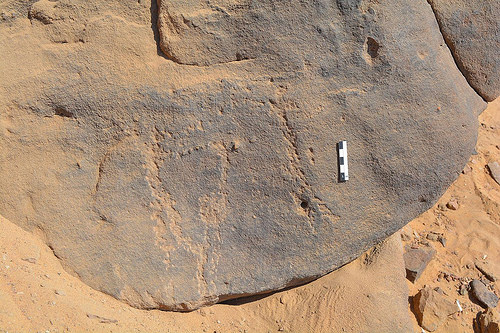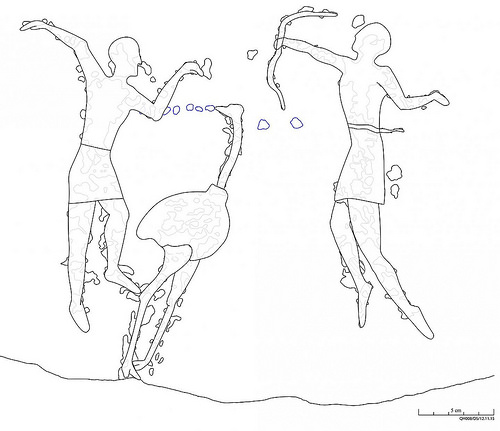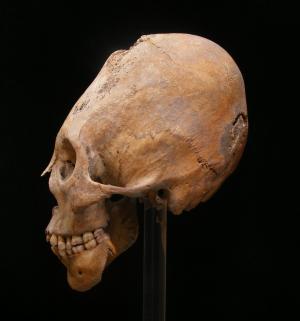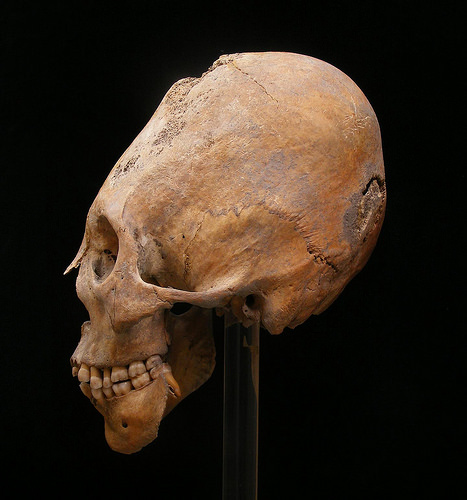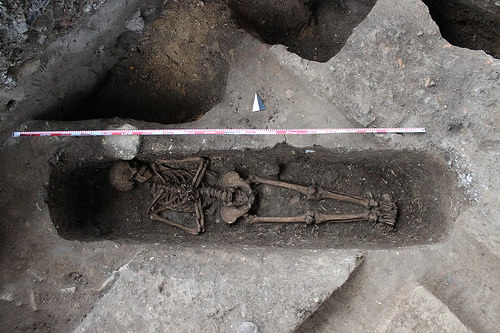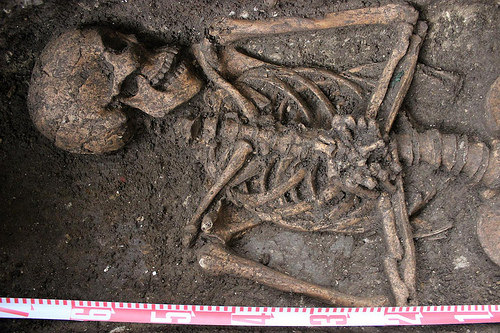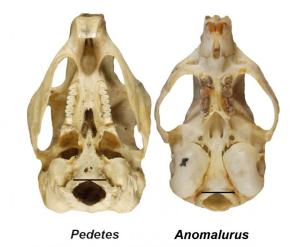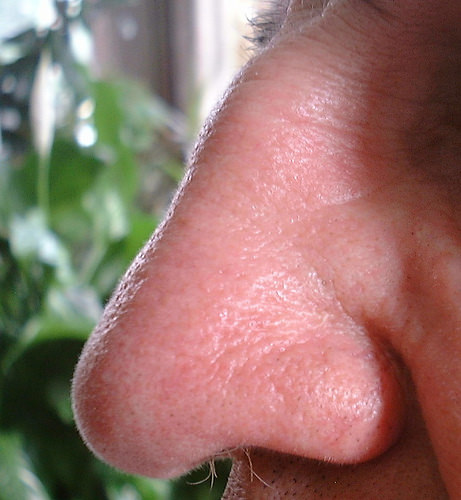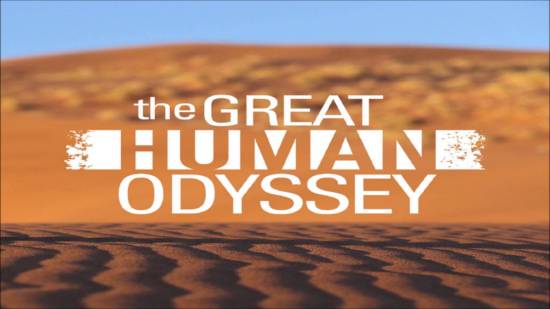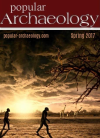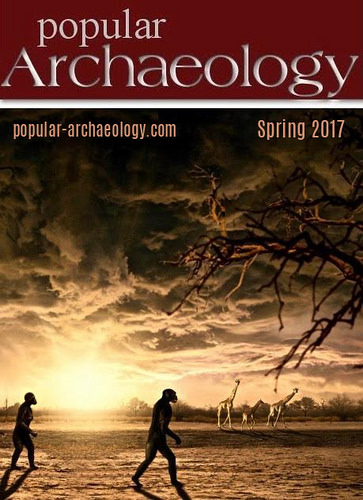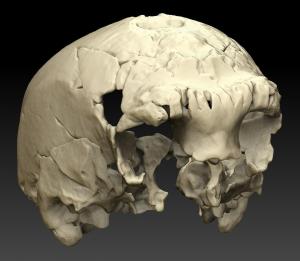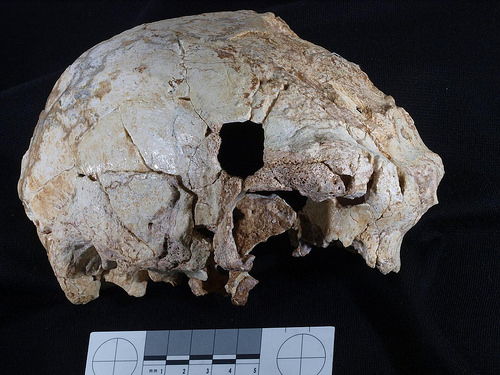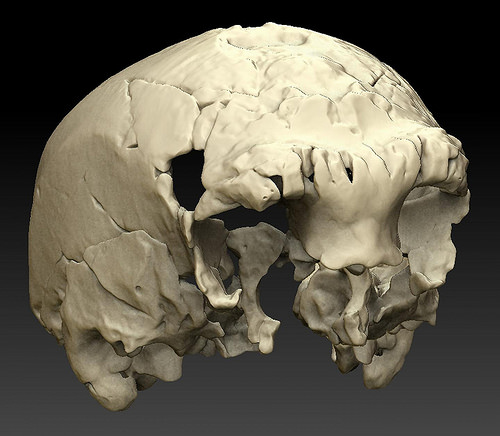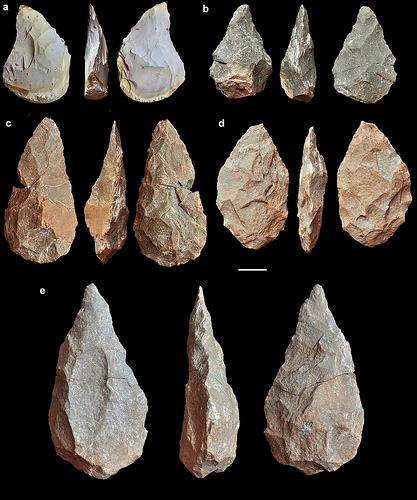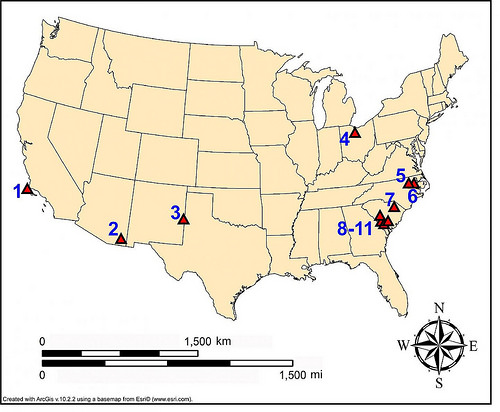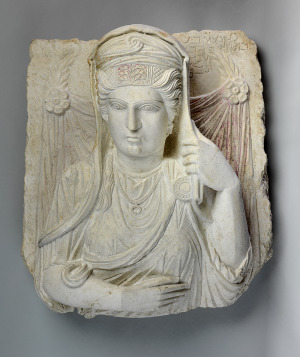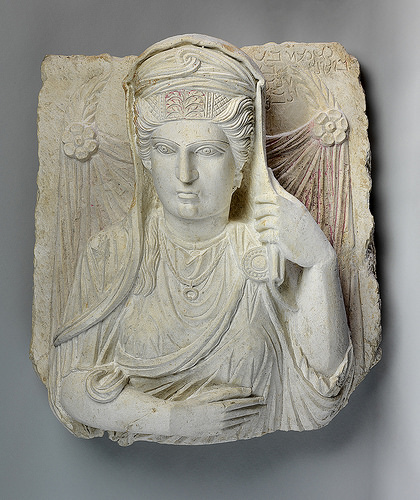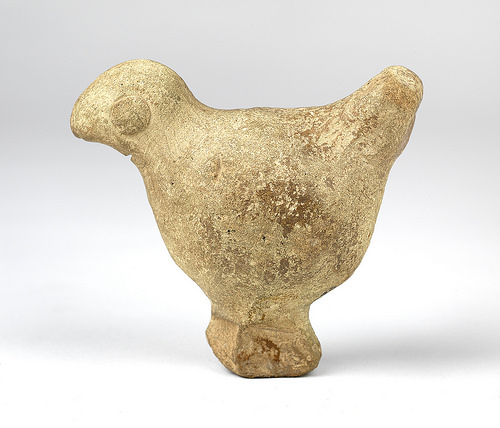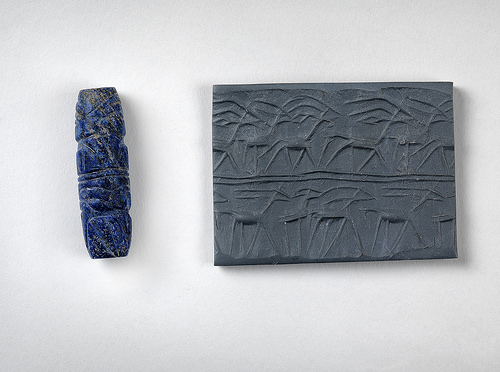
Laetoli, Tanzania — September, 2015 — A small team of scientists and skilled excavators crouched face-down into shallow square 2 x 2 meter test pits they had carefully and methodically dug into the dry volcanic sand of an African savanna landscape. They were isolated here, with the only nearest sign of civilization, a small village called Endulen, about 50 minutes away by car. The air was almost unbearably hot, typical of the long 7-month dry season in the Ngorongoro Conservation Area, a region of low-rolling light yellow-brown tropical grasslands textured with a mix of acacias, candelabra trees, jackalberry trees, whistling thorns, Bermuda grass, baobabs, and elephant grass. For millions of years, what is today the Conservation Area has been home to thousands of different species of animals, including the better-known varieties such as lions, cheetahs, hyenas, and jackals, with wildebeest, zebras and gazelles passing through. This team, led by Dr. Marco Cherin of the University of Perugia, Italy, was revealing some very ancient footprints — more than 3 million years old, to be more precise. They represented animals still common to the African landscape today, like equids, rhinoceros, giraffe, and guineafowl.
But most tantalizing were the remarkably preserved footprints of a special animal.
A human.
Or something very akin to a human.
It’s certainly not the first time scientists have found traces of prehistoric humans, or extinct human-like relatives, in this region. About 50 km to the north of where Cherin and his colleagues were digging, scientists discovered some of the first fossilized evidence of an ancient ancestral human species, or hominin, over 55 years ago at Olduvai Gorge, radically changing the direction of human evolution research; and only 150 m to the north, another iconic site in the Laetoli area revealed remarkably well-preserved human-like 3.66-million-year-old footprints in 1978. But for Cherin, the 2015 find was perhaps the greatest discovery of his life, and for good reason. The footprints he and his colleagues were now uncovering provided potentially revelatory new answers to questions that scientists have debated for decades.
_______________________________________

The Ngorongoro Conservation Area as it appears today. Gary, Wikimedia Commons
_______________________________________
Rare Finds
Discoveries at Laetoli began around 1935, when the renowned paleontologist Louis Leakey was clued into investigating the area. Leakey recovered several mammalian fossils and one left lower canine fossil tooth which later proved to be that of a hominin. Then, in 1938 and 1939, German explorer Ludwig Kohl-Larsen found hominin molars, premolars and incisors in the same area, further revealing the area’s potential. But it wasn’t until 1974 when the discovery of yet another hominin premolar generated renewed interest in the area, drawing the renowned British paleontologist Mary Leakey to investigate sites in the area, revealing new fossils representing 23 hominin individuals, including a fragmentary infant skeleton, dated to between 3.46 and 3.76 million years old.
The dating and examination of the fossil remains suggested they were from Australopithecus afarensis, the hominin species made famous by Donald Johanson with his discovery of the fossil skeletal remains of ‘Lucy’ in 1974 in the Hadar region of Ethiopia. The Lucy find was dated to about 3.2 mya (million years ago), and today scientists broadly accept a date range of between 3.85 and 2.95 mya for the Au. afarensis species.
____________________________________
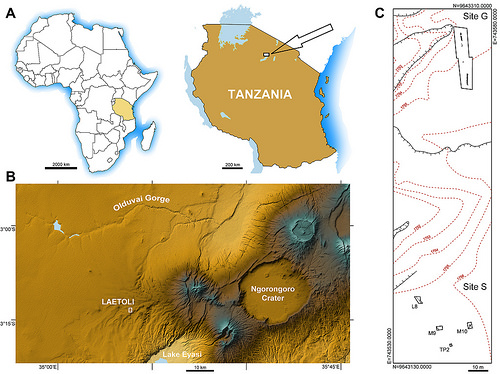
(A) Location of the study area in northern Tanzania. (B) Location of Laetoli within the Ngorongoro Conservation Area, about 50 km south of Olduvai Gorge. (C) Plan view of the area of Laetoli Locality 8 (Sites G and S). Site G was the earlier, 1978 site. Site S is the current site. Figure: Giovanni Boschian. Licensed under CC BY 4.0.
___________________________________________________
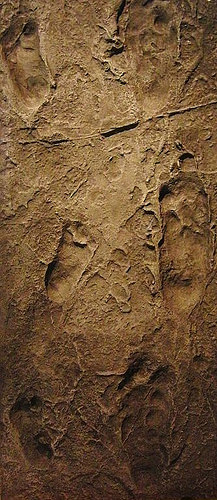
Fossils were not all that were found in the Laetoli area, however. Laetoli is perhaps best known today for its ancient animal trackways created in ash laid down millions of years ago by the eruption of a nearby volcano, the ash having transformed into a volcanic tuff over time. To date, mammal, bird, and insect prints and trails have been found in 18 out of 33 specific locations. But perhaps the most sensational find turned out to be the ancient 88 ft.- long trackway consisting of 70 footprints embedded in an excavated layer of 3.66 mya volcanic tuff — a trackway that exhibited the clear signs of something quite human. Paul Abell, a member of Leakey’s team, first encountered them in 1978 after Leakey and her team uncovered a series of other animal tracks imprinted in the same ancient tuff beginning in 1976. The new finds made headlines in science venues worldwide, and initiated a subsequent series of studies, the results of which began to shed additional light on defining the Au. afarensis hominin species, which by 1978 had already been suggested by many scientists to be a forerunner to humans on the biological evolution spectrum.
Careful examination and documentation of the trackway revealed three individuals walking together in the same direction at the same time. They were of different body sizes, with the largest individual walking side-by-side with the smallest, and an intermediate-sized individual walking just behind the largest. All walked with a human-like speed. The shape of their feet and the configuration of the toes were consistent with what was known about the feet of Au. afarensis, fossil remains of which were found in the same area and sediment layer as the footprints. Perhaps the biggest takeaway from this discovery was the affirmation that Au. afarensis was bipedal, and walked much like a modern human — a gait where the heel strikes the ground first followed by a push-off from the toes. Secondly, the footprint trackway spacing indicated a short stride, suggesting the individuals were small in stature, or at least short-legged — also consistent with the general size determination for Au. afarensis at the time.
Where was this small group of early hominins going and why? To find a more friendly location in which to sojourn? To find a new watering hole? To date, there is no evidence to confidently suggest any answers. But information gleaned from study of the site has given some clues about the environment and the circumstances. It is clear that they were treading this path shortly after the ash fell and settled over the landscape following a nearby volcanic eruption. Much like mud, the ash was still fresh with the wetness bestowed upon it by a recent light rainfall, producing a consistency good for making impressions. The eruptions had to have been rather frequent, as subsequent layers of ash fall covered the footprints and thus preserved them before they were superimposed by any other subsequent activity, such as other animals. Other prints uncovered in the same tuff layers indicated the presence of another twenty different animal species that existed at the time, including hyenas, baboons, wild cats, giraffes, rhinos, wild boars, gazelles, several kinds of antelope, buffaloes, extinct elephant relatives, birds and hares. The sediments also showed that the climate was a little wetter than the present day.
Were these hominins toolmakers? No artifacts were found, at least within the same sediment beds that contained the trackway, and no artifacts have been found to date that could be associated with Au. afarensis anywhere else in the Laetoli area—still consistent with current thinking that afarensis was not a toolmaker, unlike later hominins.
_______________________________________
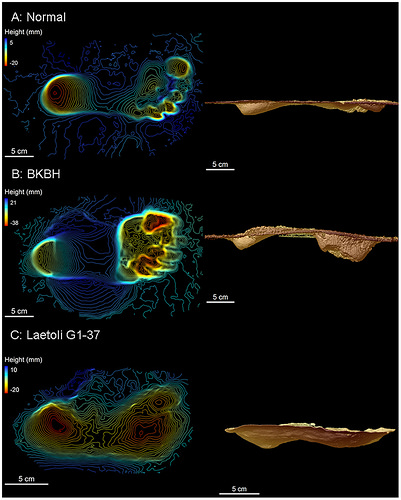
Above: Three dimensional scans of experimental footprints and a Laetoli footprint. Contours are 1 mm.
A) Contour map of modern human footprint (Subject 6) walking with a normal, extended limb gait and side view of normal, extended limb footprint.
B) Contour map of modern human footprint (Subject 6) walking with a BKBH (ape-like bent-knee, bent-hip) gait and side view of BKBH print.
C) Contour map of Laetoli footprint (G1-37) and side view of Laetoli footprint (G1-37). Note the difference in heel and toe depths between modern humans walking with extended and BKBH gaits. Laetoli has similar toe relative to heel depths as the modern human extended limb print.
This is the earliest direct evidence of kinematically human-like bipedalism currently known, and it shows that extended limb bipedalism evolved long before the appearance of the genus Homo. Since extended-limb bipedalism is more energetically economical than ape-like bipedalism, energy expenditure was likely an important selection pressure on hominin bipeds by 3.6 Ma. Image: Raichlen DA, Gordon AD, Harcourt-Smith WEH, Foster AD, Haas WR Jr Image and text from Raichlen DA, Gordon AD, Harcourt-Smith WEH, Foster AD, Haas WR Jr (2010) Laetoli Footprints Preserve Earliest Direct Evidence of Human-Like Bipedal Biomechanics. PLoS ONE 5(3): e9769. doi:10.1371/journal.pone.0009769
_______________________________________________________
Finding Chewie
As efforts in the ongoing exploration of human origins research would have it, the story at Laetoli did not end with the 1978 discoveries and their subsequent study. But it wasn’t until 2014, more than 35 years later, that the next major chapter in the area began to unfold. Plans to construct a new field museum in the Laetoli area tasked Fidelis T. Masao and Elgidius B. Ichumbaki of the University of Dar es Salaam and their co-workers to undertake a systematic survey and excavation (known as a cultural heritage impact assessment, a process required by Tanzanian law) before land preparation and construction could begin. Masao, long a well-known player in paleoanthropological research in Tanzania, and his colleagues asked Marco Cherin(1) of the School of Paleoanthropology of the University of Perugia, including researchers from the Universities of Rome, Florence and Pisa, to join them in 2015. A total of 62 randomly placed test pits were methodically and carefully excavated with the objective of exposing and examining the ‘Footprint Tuff’, the same sediments in which the Laetoli footprints were found in 1978. The first phase involved the use of small shovels to quickly remove the overlying modern topsoil (approximately 20–25 cm), graduating to lighter excavation tools such as trowels and pickaxes to dig into the underlying layers until they reached the first signs of the Footprint Tuff. From this point, Cherin and his team knew that excavation had to proceed with the highest level of caution, using small wooden tools, dental tools, small trowels and brushes.
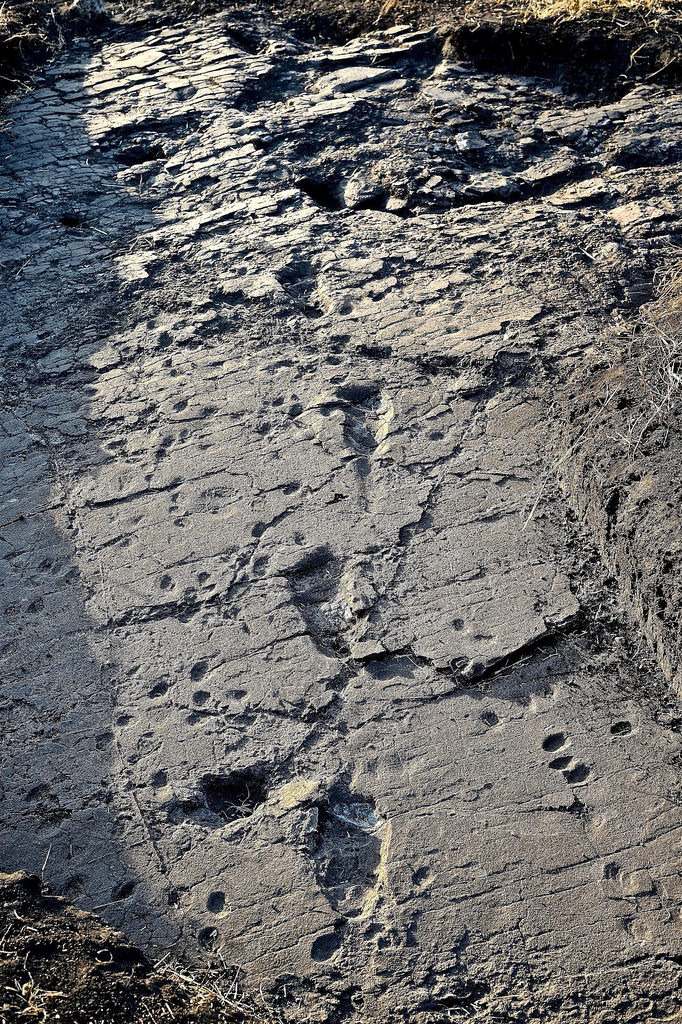
What they had hoped to find began to emerge. In this case, fourteen hominin footprints, along with those of other animals, eventually took form in three test pits. According to Cherin and his colleagues, the hominin prints represented a single individual walking to create, in this exposure, a trackway of 32 meters in an SSE to NNW direction— the very same direction as those uncovered at the earlier Laetoli footprint site in 1978. And the tracks bore a remarkable similarity to those of the earlier site, calculated with a similar walking speed. But there was one major exception — these footprints were significantly larger. Cherin and colleagues determined that they represented an individual with large relative stature and mass, standing 165 cm in height. By the end of the September 2015 field season, they discovered a second hominin trackway, this one made by a smaller individual. But the apparent size of the first, larger individual, was a surprise, particularly given the assessment that this person, like those who made the trackways at the earlier Laetoli site, was likely a member of the Au. afarensis species, a species generally thought to be significantly smaller in stature than hominins that evolved later in the human evolutionary spectrum. “We nicknamed him Chewie, after the famous Chewbacca of Star Wars,” said Cherin.
All footprints, including those of other animals, were very carefully cleaned using soft brushes, revealing greater detail and to better measure, photograph, trace and map them for continuing study. Apart from the hominin footprints, the animal tracks provided critical information about the kind of environment where Chewie made his home — a mosaic of grassland, woodland, dry tropical bushland, and riverine forest — much like the savanna environment that exists there today.
_____________________________________________
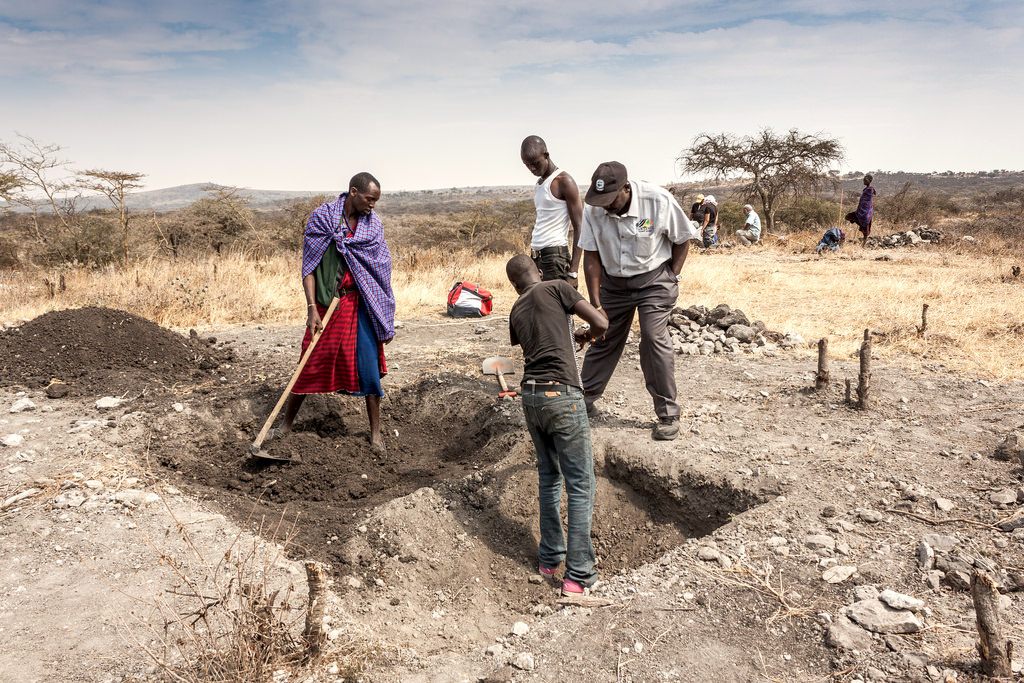
Fidelis T. Masao (University of Dar es Salaam) (right) coordinates the digging operations with the Masai assistants. Photo Sofia Menconero. Licensed under CC BY 4.0.
___________________________________________________________
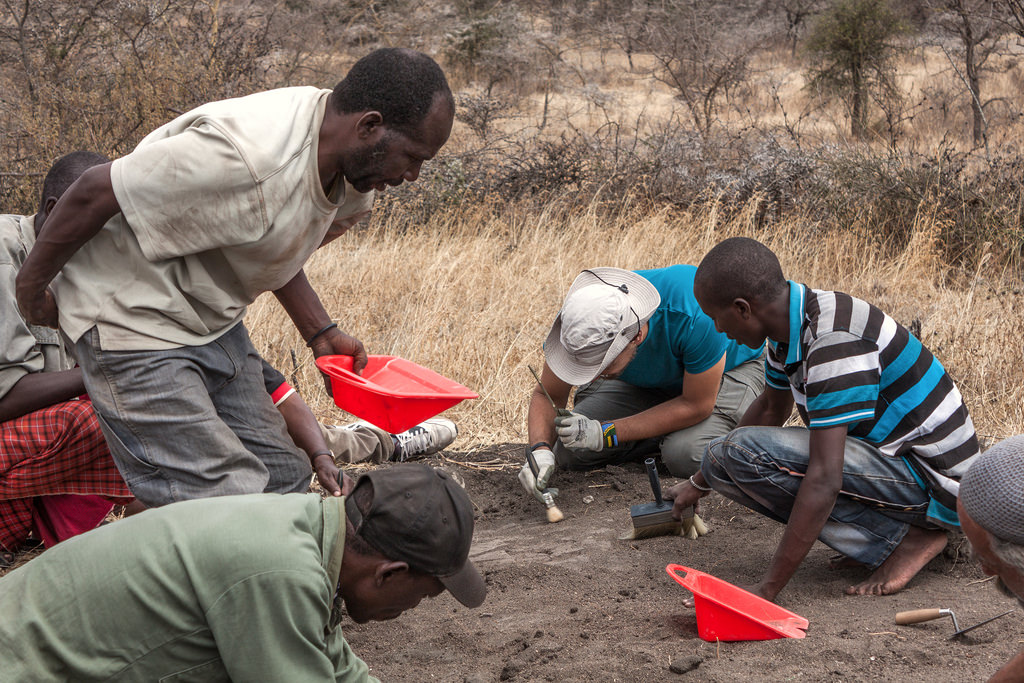
Preliminary digging and cleaning operations at Laetoli Site S. Photo Sofia Menconero. Licensed under CC BY 4.0.
_____________________________________________
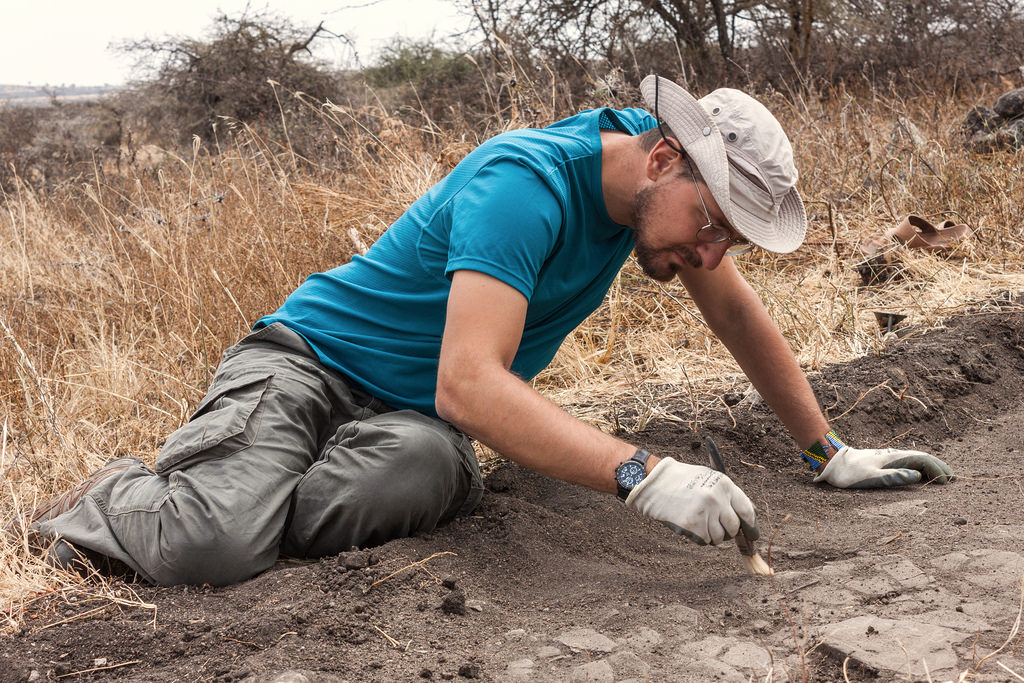
Marco Cherin (University of Perugia) cleans the footprint-bearing surface at Laetoli Site S. Photo Sofia Menconero. Licensed under CC BY 4.0
_____________________________________________________________
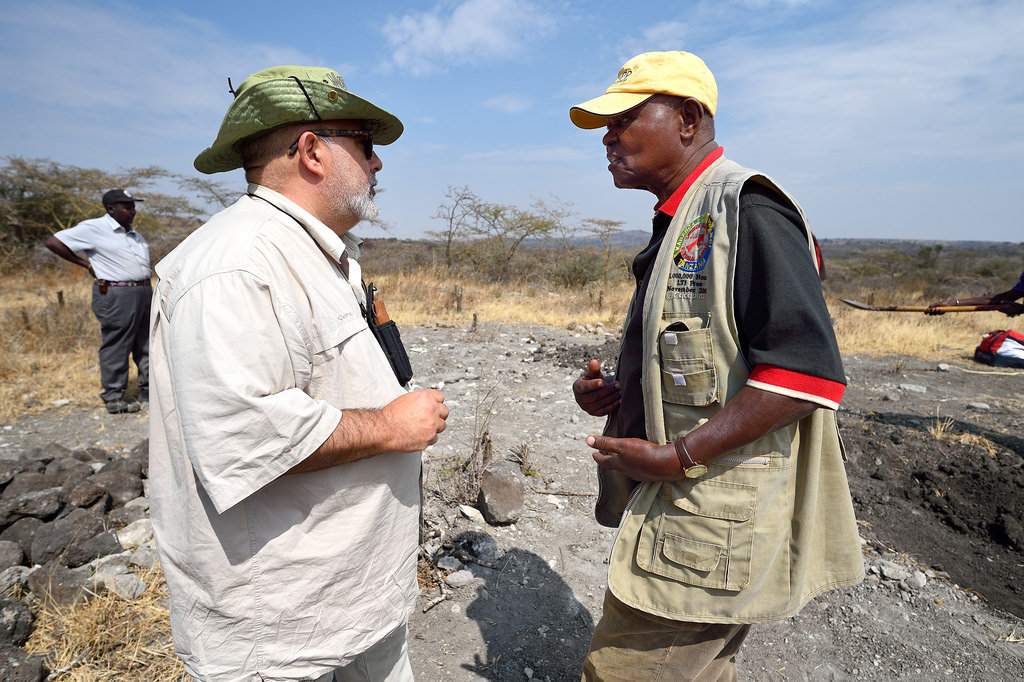
Giorgio Manzi (Sapienza University of Rome) and Fidelis T. Masao (University of Dar es Salaam) discuss the new discovery at Laetoli Site S. Photo Raffaello Pellizzon. Licensed under CC BY 4.0.
______________________________________________________________
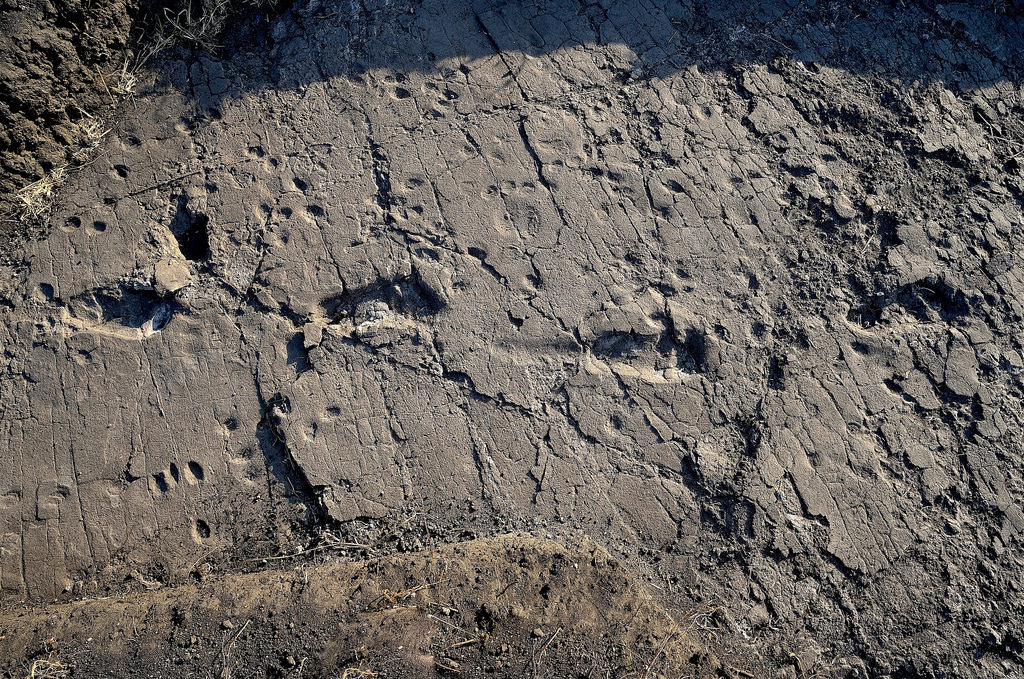
Four hominin tracks photographed at sunset in test-pit L8 at Laetoli Site S. Photo Raffaello Pellizzon. Licensed under CC BY 4.0.
________________________________________________________________
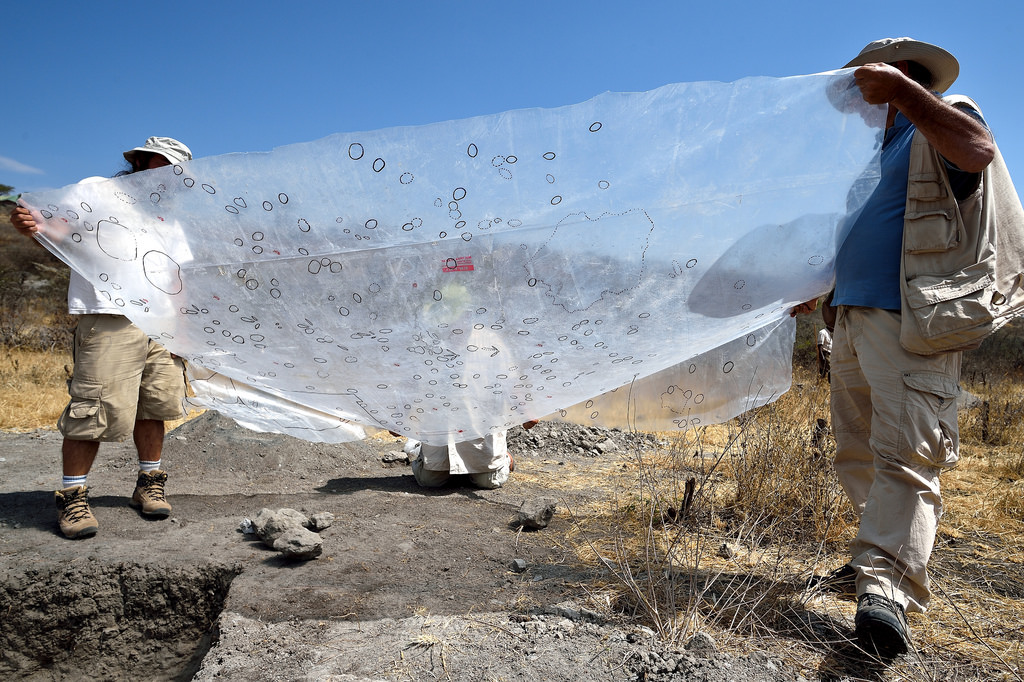
Before the photogrammetric survey, all surfaces with footprints are sketched on plastic sheets. Photo Raffaello Pellizzon. Licensed under CC BY 4.0.
________________________________________________________________
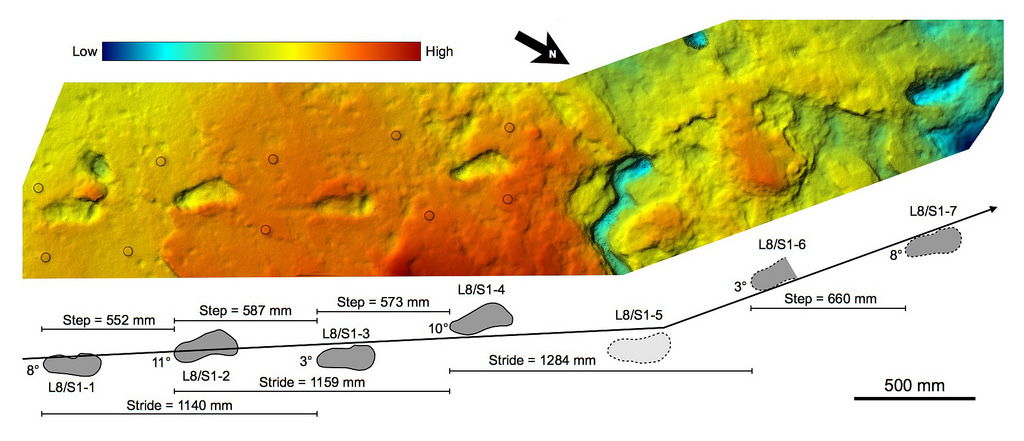
Shaded 3D photogrammetric elevation model of the L8 trackway. Color renders heights as in the color bar. Figure Dawid A. Iurino and Sofia Menconero. Licensed under CC BY 4.0.
________________________________________________________________
Getting to Know Afarensis
The footprint finds at the new site brought up the count by two hominin individuals, making it now five individuals for whom evidence has been found at Laetoli. Five individuals walking on the same ancient, soft, wet ash surface at the same time, 3.66 million years ago, long before the genus Homo, the genus to which modern day humans belong, walked the earth.
Were they all part of the same group?
Cherin and his colleagues think so.
According to Cherin, their careful study of the geology and morphology of the area, including the detailed characteristics of the newly exposed stratigraphic sequence, provided “a very good margin of confidence”* that the newly discovered tracks belonged to the same surface as that found in the Footprint Tuff at the earlier site. “They were walking together on the same paleosurface, in the same direction and with the same speed,” says Cherin. “This allows us to consider the five individuals (the two in our [new] ‘Site S’ and the three in the 1970s ‘Site G’) as part of the same social group of Australopithecus afarensis.”
There may be some room for doubt, however. “The correlation between Site G and Site S cannot be absolutely indisputable, at least for the time being, because the original profile [of Site G] could not be examined directly,” state the study authors in the subject report. Moreover, “it must be pointed out that extra-fine correlation between outcrops, even in a depositional environment with moderate lateral variability like the Footprint Tuff deposition area, can be affected by major uncertainty.”*
Nonetheless, footprint evidence like this can potentially say much about the footprint makers. “Footprints are a rare and unique form of evidence of our ancestors, both physical and behavioral,” says Briana Pobiner, a key paleoanthropologist with the Smithsonian Institution in Washington, D.C. “Fossils can tell us about the general body size and shape, but with footprints we can learn about how fast ancient people walked or ran and what kinds of social groups they were in.”
Pobiner speaks from experience. She was part of a team that investigated more than 400 footprints uncovered at another site in Tanzania called Engare Sero. Here, modern humans — Homo sapiens — walked across a surface of ash laid down between 5,000 and 19,000 years ago, spewed out from the nearby volcano, Ol Doinyo Lengai. The study of those prints revealed that some of the individuals were moving at a jogging pace, and one set of prints suggested the possibility of a broken toe. Other prints revealed what seemed to be a group of about a dozen associated people composed mostly of women and children, suggesting a particular social unit of people, or at least part of one, traveling southwest to an unknown destination. In this place, Pobiner shared some of the same feelings Cherin, Masao and others must have felt at Leotoli: “The opportunity to literally walk next to the footprints of an ancient human, to hundreds of them, was haunting,” Pobiner continued. “They were RIGHT THERE, in the same spot I was standing, but 19,000 years ago. They walked where I walked. What did they see? What were they thinking? The scenery today is stark and beautiful, with the volcano towering in the background; it’s hot, dry, and dusty. Was it the same back then? It’s hard not to feel an eerie, emotional connection doing research on human footprints.”
Laetoli and Egare Sero are not the only places discoveries like this have taken place — Koobi Fora, another famous hominin site in East Africa, features hominin footprints that are 1.5 mllion years old, the Willandra Lakes site in Australia revealed 700 human footprints that are 20,000 years old, and in South Africa two sites along the coast have yielded prints dated as much as 120,000 years ago.
But all of these sites are rare when compared to the total fossil and archaeological record bearing on hominins.
What distinguishes the Laetoli discoveries from others, according to Cherin and colleagues, are the possible new implications the latest finds might have for understanding one of humankind’s earliest ancestral lineages, the Australopithecines, and more specifically, Au. afarensis. More than behavior and movement, the tracks at Site S may have revealed something about size and social structure.
“The remarkable stature of Chewie (165 cm) is the highest ever estimated for any australopithecine and is similar to average values of more derived hominin species, such as Homo erectus or Homo sapiens itself,” says Cherin. “This demonstrates that the increase of stature did not occur along a linear trend during human evolution and is not directly linked to encephalization.”
In other words, increase in height and/or body size does not necessarily conform to the traditional thinking that hominins like Homo erectus, a more derived or ‘advanced’ extinct human species that emerged later in the fossil record, were the first “tall” or more standard-sized humans, correlating with a similar increase in brain size.
On the other hand, was Chewie an aberration among his species peer group? After all, today we know there are some unusually tall people among our own world population, deviating from the norm. Did Cherin and his colleagues simply come across one of those deviants among the Australopithecines? The discovery of additional tracks laid down during the same time horizon in East Africa and in other locations would of course likely shed additional light and provide evidence to either support or detract from Cherin’s tentative conclusion.
Dimorphism and Gorillas
The Site S tracks revealed some additional implications, according to Cherin.
“Given the impressive stature, Chewie was very likely a large male,” he suggests. “Another three Laetoli individuals have a stature of about 130-145 cm, thus being probably females (or sub-adults). The smallest individual (113 cm) was probably a juvenile. This social structure (i.e., one large male with more than one smaller female) is similar to that of the living gorilla, in which one male has a “harem” of smaller mates with their cubs. This similarity allows us to hypothesize that Au. afarensis may have been a polygynous species.”
The published study report summarizes the rationale for his thinking:
The impressive record of bipedal tracks from Laetoli Locality 8 (Site G and the new Site S) may open a window on the behaviour of a group of remote human ancestors, envisaging a scenario in which at least five individuals (G1, G2, G3, S1 and S2) were walking in the same time frame, in the same direction and at a similar moderate speed. This aspect must be evaluated in association with the pronounced body-size variation within the sample, which implies marked differences between age ranges and a considerable degree of sexual dimorphism in Au. afarensis. Significant implications about the social structure of this stem hominin species derive from these physical and behavioural characteristics, suggesting that reproductive strategies and social structure among at least some of the early bipedal hominins were closer to a gorilla-like model than to chimpanzees or modern humans.*
Some scientists, no doubt, have and will continue to take issue with the conclusions. Human evolution research, by its very nature, has always been a hotbed for debate, and continuing research and discovery has historically changed what we know about human evolution, new studies and finds either debunking or confirming previous hypotheses or conclusions. But for now, Cherin’s conclusions remain an intriguing possibility.
__________________________________________
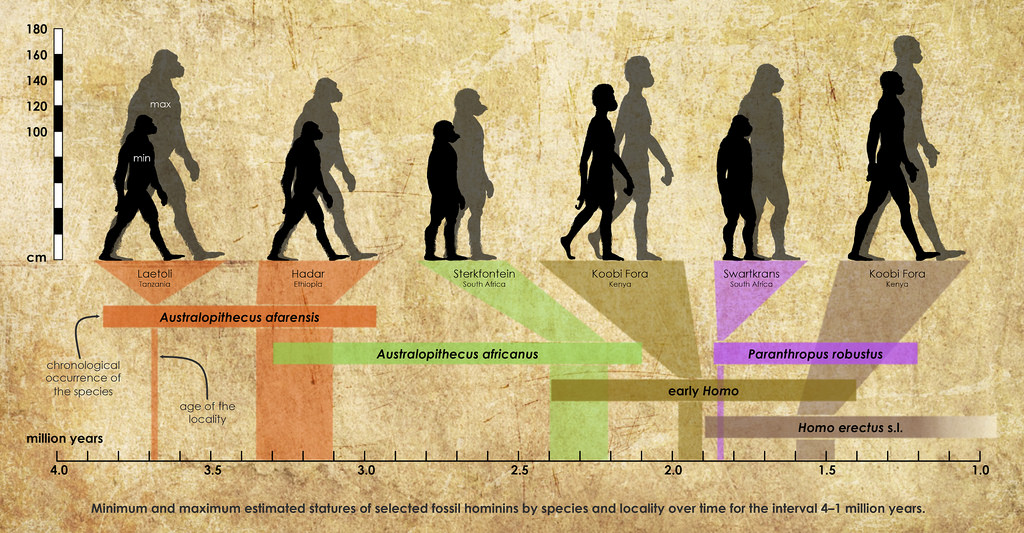
Minimum and maximum estimated statures of selected fossil hominins by species and locality over time for the interval 4–1 million years. Figure Marco Cherin. Licensed under CC BY 4.0.
____________________________________
Australopithecus afarensis: Defining a species
The story of the discovery of Australopithecus afarensis actually began with Donald Johanson and a team of scientists and excavators at a remote site in the area of Hadar, Ethiopia on November 24, 1974. Here, while surveying and mapping the area, Johanson spotted a forearm bone, skull bone, femur, lower jaw bone, pelvis, and some rib bones at the surface, identifying them as those of a hominin. This sparked two weeks of excavation resulting in the recovery of several hundred more bone fragments that constituted 40 percent of what was determined to be a single hominin (based primarily on the fact that there was no duplication in the recovered bone element anatomy). Nick-named “Lucy” by the excavators, the find became the first and perhaps most iconic specimen of the Au. afarensis hominin species. Examination of the bones further indicated that Lucy was indeed a female, standing about three-and-a-half feet tall and weighing between 60 to 65 pounds — diminutive by modern human standards — with a small brain, not much larger than a chimpanzee. Using paleomagnetic, paleontological, and sediment studies, researchers dated Lucy to almost 3.18 million years old.
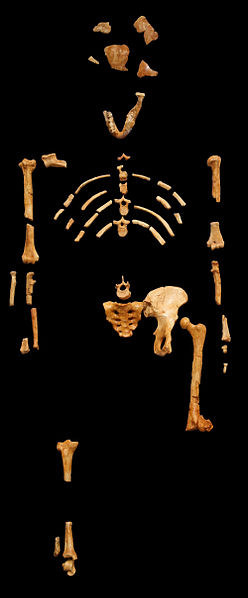 Among the most revelatory findings from examination of Lucy’s bones was the determination that she walked upright, much like humans, suggesting a life-way much different than the other primates, where knuckle-walking and an arboreal lifestyle (movement in trees) was most characteristic. But Lucy’s arms were proportionately longer than those of later hominins and modern humans, a characteristic more like those of chimpanzees and the the other Great Apes. A recent study, however, has shed some additional light on the question. That study, by Christopher Ruff and colleagues of Johns Hopkins University and published November 30, 2016 in the open-access journal PLOS ONE, involved taking X-ray microtomography scans of Lucy’s upper arm bone (humerus) and upper leg bone (femur) to produce cross-sections for 3D modeling. This revealed that Lucy’s humerus and femur bone strengths were somewhere between the arm and leg bone strengths of today’s chimpanzees and humans, suggesting that Lucy, and by extension the Au. afarensis species, spent a significant amount of time using arms to move through trees. Based on modern animal analogs of behavior, this meant that Au. afarensis used trees to forage for food and escape predators. Moreover, Ruff’s analysis suggested that afarensis’ walking gait may have been somewhat different and less efficient than that of modern humans. In any case, however, the footprints at Laetoli have been considered strong confirmation that Au. afarensis walked upright as a sustained activity. (Pictured right, the full skeletal array of Lucy’s remains, 120, Wikimedia Commons)
Among the most revelatory findings from examination of Lucy’s bones was the determination that she walked upright, much like humans, suggesting a life-way much different than the other primates, where knuckle-walking and an arboreal lifestyle (movement in trees) was most characteristic. But Lucy’s arms were proportionately longer than those of later hominins and modern humans, a characteristic more like those of chimpanzees and the the other Great Apes. A recent study, however, has shed some additional light on the question. That study, by Christopher Ruff and colleagues of Johns Hopkins University and published November 30, 2016 in the open-access journal PLOS ONE, involved taking X-ray microtomography scans of Lucy’s upper arm bone (humerus) and upper leg bone (femur) to produce cross-sections for 3D modeling. This revealed that Lucy’s humerus and femur bone strengths were somewhere between the arm and leg bone strengths of today’s chimpanzees and humans, suggesting that Lucy, and by extension the Au. afarensis species, spent a significant amount of time using arms to move through trees. Based on modern animal analogs of behavior, this meant that Au. afarensis used trees to forage for food and escape predators. Moreover, Ruff’s analysis suggested that afarensis’ walking gait may have been somewhat different and less efficient than that of modern humans. In any case, however, the footprints at Laetoli have been considered strong confirmation that Au. afarensis walked upright as a sustained activity. (Pictured right, the full skeletal array of Lucy’s remains, 120, Wikimedia Commons)
To date, scientists have recovered fossils from more than 300 Au. afarensis individuals discovered at various sites, such as Hadar and Dikika, in Ethiopia and Laetoli in Tanzania and have placed the species within a 3.85 – 2.95 mya date range.
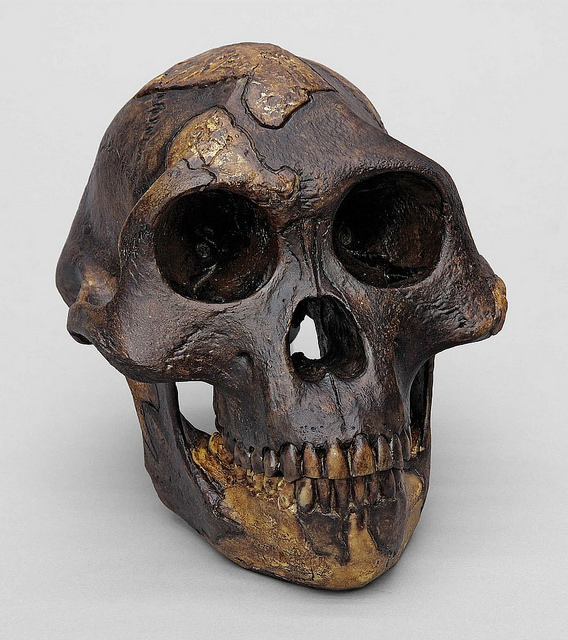
Bone Clones skull cast of Australopithecus afarensis “Lucy” Wikimedia Commons
__________________________________________
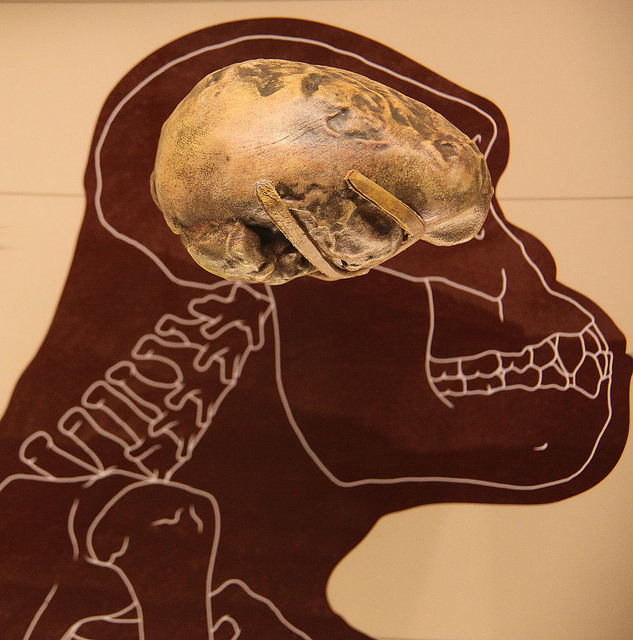
An endocast of the Australopithecus afarensis brain on display in the Hall of Human Origins in the Smithsonian National Museum of Natural History in Washington, D.C. To create an endocast, scientists fill the inside of the skull with a rubber-like material, making a model of the brain. The brain and its blood vessels leave imprints on the inside of the skull. Because more advanced brains have smaller veins and many more folds and lobes, an endocast is very useful in determing how intelligent a human ancestor might have been, and what portions of its brain were more developed. Tim Evanson, Wikimedia Commons
___________________________________________________

Australopithecus afarensis paleoanthropological sites in East Africa – Tanzania, Kenya and Ethiopia Chartep, Wikimedia Commons
________________________________________________________
Based on research, if one were to observe a living Au. afarensis, one would see a creature that looked much like an ape with some human-like features. It had apelike face proportions and a small braincase and apelike long arms with hands exhibiting curved fingers. But it also had small canine teeth like other, later early humans and walked upright on a regular basis. Many scientists suggest that its adaptations for both walking upright and living in trees helped the species survive more than 900,000 years before going extinct, much longer than the time our own species, Homo sapiens, has existed.
_______________________________________
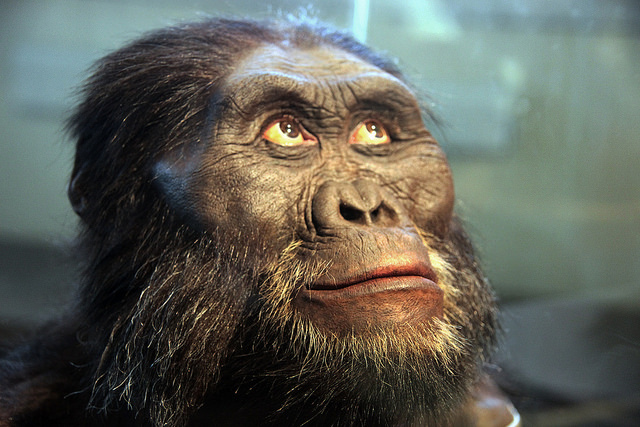
A reconstruction of the head of an Australopithecus afarensis on display in the Hall of Human Origins in the Smithsonian National Museum of Natural History in Washington, D.C. Reconstruction by John Gurche; photographed by Tim Evanson, Wikimedia Commons
____________________________________________________
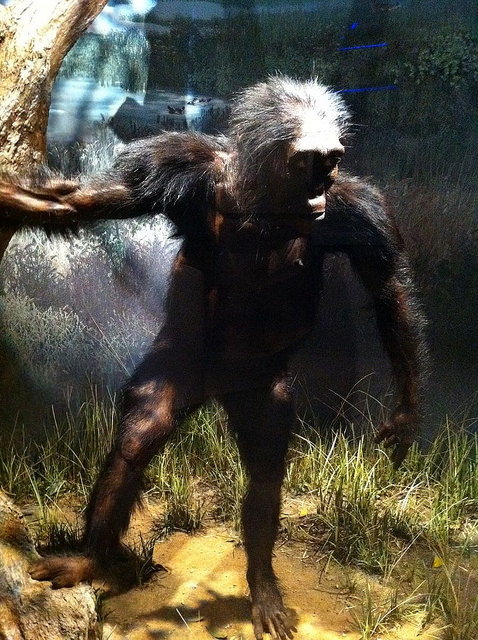
A representation of Lucy at the Smithsonian National Museum of Natural History, Washington DC, USA, Mpinedag, Wikimedia Commons
_______________________________________
Site A and a Hominin Mystery
Though the big splash made from the discoveries at sites S and G continues to loom large in the history of human evolution research, these remarkable finds were not the only revelations uncovered at Laetoli. In 1976, two years before the excavations at sites S and G, Peter Jones and Philip Leakey identified a set of potential fossilized hominin footprints through excavations at nearby Site A. This site, a 490 m2 area dated to 3.66 million years ago (Ma), consisted of 18,400 animal tracks and a trackway featuring 5 footprints that appeared at first blush to be possibly hominin. The footprints indicated mammalian biped movement with “a rolling and probably slow-moving gait, with the hips swivelling at each step,”** and “somewhat shambling, with one foot crossing in front of the other” [cross-stepping, a behavior not usually attributed to a hominin gait]***
There was something therefore clearly curious about the footprints, and researchers were inconclusive about the footprint makers, entertaining the hypothesis that they could have been left by a juvenile ursid [bear]. Without further study and additional clearing of the prints’ matrix fill, scientists deferred further consideration to another time.
Enter here Dr. Ellison McNutt, Assistant Professor, Ohio University Heritage College of Osteopathic Medicine, and a project team of researchers, In 2019, they re-located, excavated and cleaned the site A trackway, exposing the subject footprints more cleanly for detailed study. In the process, they produced a digital archive using 3D photogrammetry and laser scanning and compared the footprints to those of humans, chimpanzees, and American black bears. After extensive data collection, experimentation and comparative analysis, they concluded that the footprints “resemble those of hominins more than ursids” consistent with the “original interpretation of a small, cross-stepping bipedal hominin” as suggested from the initial excaation in 1976.****
What Hominin?
It would be easy to assume that the hominin footprints at Site A, given the similar date range and shared ancient Pliocene environment between the locations of sites S, G and A, should be attributable to A. afarensis. But McNutt and colleagues suggest otherwise in their 2021 published study report:
“We therefore conclude that the site A footprints were made by a bipedal hominin with a distinct and presumably more primitive foot than A. afarensis…..foot morphology and gait kinematics inferred from the preserved footprints precludes them from having been made by A. afarensis.”****
Given this conclusion, then, what other hominin produced these footprints? Available data is not robust enough to make that determination. It therefore remains a mystery until further discoveries, research and data from Laetoli and other Pliocene sites can better inform an emerging new paradigm where multiple taxa of hominins coexisted or at least overlapped in time on the same ancient African landscape.
___________________________________
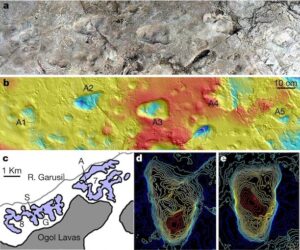
a, A model of site A generated using photogrammetry showing the five hominin footprints. b, Corresponding contour map of the site generated from a 3D surface scan with scale bar. c, Map of Laetoli localities 7 and 8, indicating the positions of bipedal trackways A, G and S (redrawn from ref. 49). d, e, Topographical maps of the two best preserved A footprints, A2 (d) and A3 (e). http://creativecommons.org/licenses/by/4.0/
___________________________________
Moving Forward
Like many other hominin sites throughout Africa, scientists would likely tell us that there is probably much more to glean from the areas in which the sites are located, adding to the record of early human existence on the African continent. Laetoli has only revealed a fraction of the trackways that may still lie buried beneath the modern dry volcanic sand of this ancient savanna grassland. Cherin and his colleagues plan to return to the site. “We are now collecting funding for new field seasons at Laetoli,” says Cherin. “Our goal is to expose some additional footprints to study the locomotion of the track-makers and, simultaneously, to elaborate a proper conservation strategy to make these incredible findings available for future generations.”
The story of Laetoli is clearly not over.
___________________________________________________

Reconstruction of the Laetoli palaeolandscape and the Au. afarensis group 3.66 million years ago. Artwork Dawid A. Iurino. Licensed under CC BY 4.0.
__________________________________________________
(1) Marco Cherin is a vertebrate paleontologist at the University of Perugia, Italy, whose first research topic is the systematics, biology, ecology and evolution of Plio-Pleistocene terrestrial mammals of Europe and East Africa. He works mainly on terrestrial carnivores, such as canids, felids, mustelids, etc. In 2010, together with his colleague Angelo Barili (Natural History Museum, University of Perugia), he began a collaborative relationship with Fidelis Masao (University of Dar es Salaam). Every year they organize a field workshop in Olduvai Gorge, a famous Tanzanian paleoanthropological site not far from Laetoli.
*Masao, et al., New Footprints from Laetoli (Tanzania) provide evidence for marked body size variation in early hominins, eLife 2016;5:e19568.DOI: 10.7554/eLife.19568
**Leakey, M. Pliocene footprints at Laetoli, northern Tanzania. Antiquity 52, 133 (1978).
***Leakey, M. D. & Hay, R. L. Pliocene footprints in the Laetoli Beds at Laetoli, northern Tanzania. Nature 278, 317–323 (1979).
****McNutt, E.J., Hatala, K.G., Miller, C. et al. Footprint evidence of early hominin locomotor diversity at Laetoli, Tanzania. Nature 600, 468–471 (2021). https://doi.org/10.1038/s41586-021-04187-7. Material and applicable images in this article relating to Site A are drawn from this study under the following license: http://creativecommons.org/licenses/by/4.0/
Image, third from top: Laetoli footprints, replica. Exhibit in the National Museum of Nature and Science, Tokyo, Japan. Momotarou2012, Wikimedia Commons
Image, sixth from top: Southern portion of test-pit L8 at Laetoli Site S. Photo Raffaello Pellizzon. Licensed under CC BY 4.0.
___________________________________________________


